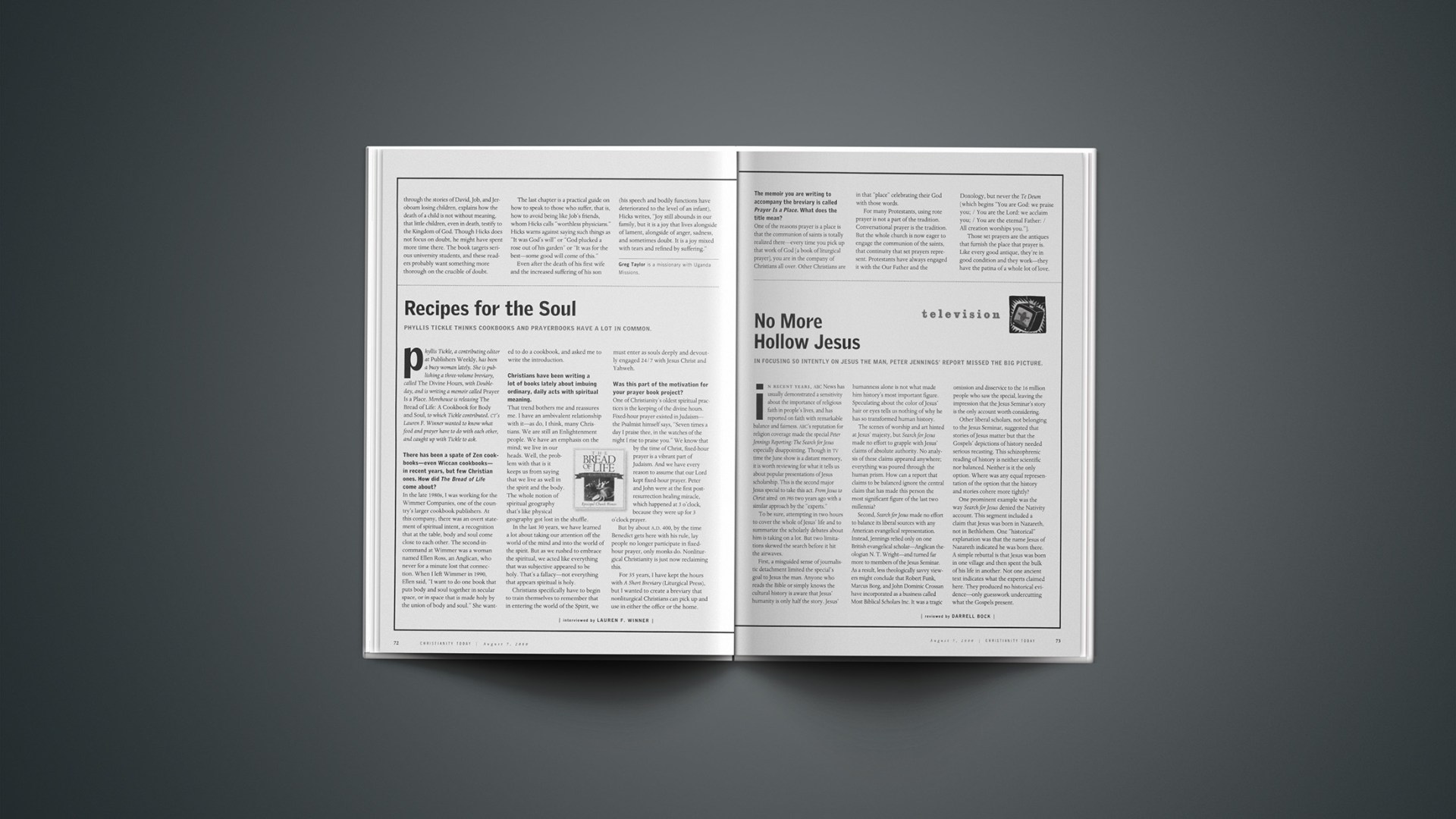Phyllis Tickle, a contributing editor atPublishers Weekly, has been a busy woman lately. She is publishing a three-volume breviary, called The Divine Hours, with Doubleday, and is writing a memoir called Prayer Is a Place. Morehouse is releasing The Bread of Life: A Cookbook for Body and Soul, to which Tickle contributed. CT’s Lauren F. Winner wanted to know what food and prayer have to do with each other, and caught up with Tickle to ask.
There has been a spate of Zen cookbooks—even Wiccan cookbooks—in recent years, but few Christian ones. How did The Bread of Life come about?
In the late 1980s, I was working for the Wimmer Companies, one of the country’s larger cookbook publishers. At this company, there was an overt statement of spiritual intent, a recognition that at the table, body and soul come close to each other. The second-in-command at Wimmer was a woman named Ellen Ross, an Anglican, who never for a minute lost that connection. When I left Wimmer in 1990, Ellen said, “I want to do one book that puts body and soul together in secular space, or in space that is made holy by the union of body and soul.” She wanted to do a cookbook, and asked me to write the introduction.
Christians have been writing a lot of books lately about imbuing ordinary, daily acts with spiritual meaning.
That trend bothers me and reassures me. I have an ambivalent relationship with it—as do, I think, many Christians. We are still an Enlightenment people. We have an emphasis on the mind; we live in our heads. Well, the problem with that is it keeps us from saying that we live as well in the spirit and the body. The whole notion of spiritual geography that’s like physical geography got lost in the shuffle.
In the last 30 years, we have learned a lot about taking our attention off the world of the mind and into the world of the spirit. But as we rushed to embrace the spiritual, we acted like everything that was subjective appeared to be holy. That’s a fallacy—not everything that appears spiritual is holy.
Christians specifically have to begin to train themselves to remember that in entering the world of the Spirit, we must enter as souls deeply and devoutly engaged 24/7 with Jesus Christ and Yahweh.
Was this part of the motivation for your prayer book project?
One of Christianity’s oldest spiritual practices is the keeping of the divine hours. Fixed-hour prayer existed in Judaism—the Psalmist himself says, “Seven times a day I praise thee, in the watches of the night I rise to praise you.” We know that by the time of Christ, fixed-hour prayer is a vibrant part of Judaism. And we have every reason to assume that our Lord kept fixed-hour prayer. Peter and John were at the first post-resurrection healing miracle, which happened at 3 o’clock, because they were up for 3 o’clock prayer.
But by about A.D. 400, by the time Benedict gets here with his rule, lay people no longer participate in fixed-hour prayer, only monks do. Nonliturgical Christianity is just now reclaiming this.
For 35 years, I have kept the hours with A Short Breviary (Liturgical Press), but I wanted to create a breviary that nonliturgical Christians can pick up and use in either the office or the home.
The memoir you are writing to accompany the breviary is called Prayer Is a Place. What does the title mean?
One of the reasons prayer is a place is that the communion of saints is totally realized there—every time you pick up that work of God [a book of liturgical prayer], you are in the company of Christians all over. Other Christians are in that “place” celebrating their God with those words.
For many Protestants, using rote prayer is not a part of the tradition. Conversational prayer is the tradition. But the whole church is now eager to engage the communion of the saints, that continuity that set prayers represent. Protestants have always engaged it with the Our Father and the Doxology, but never the Te Deum [which begins “You are God: we praise you; / You are the Lord: we acclaim you; / You are the eternal Father: / All creation worships you.”].
Those set prayers are the antiques that furnish the place that prayer is. Like every good antique, they’re in good condition and they work—they have the patina of a whole lot of love.
Related Elsewhere
Tickle’s official Web site, phyllistickle.com , has information about Tickle and her works, especially The Divine Hours.
The Bread of Life: A Cookbook for Body and Soul is available at the Christianity Online bookstore and other book retailers, as are Tickle’s The Divine Hours , God Talk in America , and Rediscovering the Sacred .
Morehouse offers some promotional information about The Bread of Life on its site.
Lauren F. Winner, who interviewed Tickle for this article, reviewedThe Bread of Life for Beliefnet. The multifaith site also has an excerpt from the book, a review of Tickle’s The Divine Hours, and an article by Tickle (which originally appeared in Spirituality & Health) on praying the hours .
Virginia Stem Owens penned a different perspective on Christianity and food for the January 11, 1999 issue of Christianity Today.
Your Church, a Christianity Today sister publication, has tips on how to create a church cookbook .
Copyright © 2000 Christianity Today. Click for reprint information.










